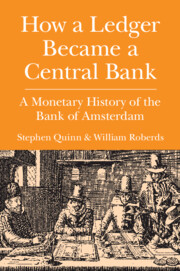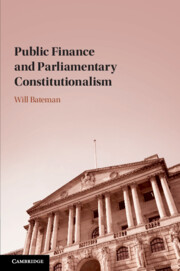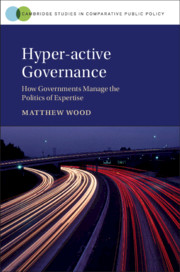Refine search
Actions for selected content:
24 results
Private lenders of last resort: the debates around central banking in Brazil in the 1920s
-
- Journal:
- Financial History Review , First View
- Published online by Cambridge University Press:
- 22 September 2025, pp. 1-21
-
- Article
-
- You have access
- Open access
- HTML
- Export citation
8 - Greening Central Banks
-
- Book:
- The Macroeconomics of Decarbonisation
- Published online:
- 01 February 2024
- Print publication:
- 08 February 2024, pp 291-314
-
- Chapter
- Export citation
1 - Similar yet Different?
-
- Book:
- How a Ledger Became a Central Bank
- Published online:
- 16 November 2023
- Print publication:
- 30 November 2023, pp 1-16
-
- Chapter
- Export citation

How a Ledger Became a Central Bank
- A Monetary History of the Bank of Amsterdam
-
- Published online:
- 16 November 2023
- Print publication:
- 30 November 2023
9 - ‘Nobody’s Child’
- from Part II - Specific
-
-
- Book:
- The Spread of the Modern Central Bank and Global Cooperation
- Published online:
- 02 November 2023
- Print publication:
- 16 November 2023, pp 225-267
-
- Chapter
- Export citation
7 - The Bank of Poland and Monetary Policy during the Interwar Period
- from Part II - Specific
-
-
- Book:
- The Spread of the Modern Central Bank and Global Cooperation
- Published online:
- 02 November 2023
- Print publication:
- 16 November 2023, pp 160-196
-
- Chapter
- Export citation
11 - Macroeconomic Policies and the New Central Bank in Turkey, 1929–1939
- from Part II - Specific
-
-
- Book:
- The Spread of the Modern Central Bank and Global Cooperation
- Published online:
- 02 November 2023
- Print publication:
- 16 November 2023, pp 301-319
-
- Chapter
- Export citation
12 - Payment Systems Regulation
- from Part III
-
- Book:
- Modern Economic Regulation
- Published online:
- 25 May 2023
- Print publication:
- 08 June 2023, pp 415-452
-
- Chapter
- Export citation
4 - How a Fiat Standard Works
-
- Book:
- Better Money
- Published online:
- 16 March 2023
- Print publication:
- 23 March 2023, pp 121-152
-
- Chapter
- Export citation
Whatever it takes to save the planet? Central banks and unconventional green policy
-
- Journal:
- Macroeconomic Dynamics / Volume 28 / Issue 2 / March 2024
- Published online by Cambridge University Press:
- 13 February 2023, pp. 299-324
-
- Article
-
- You have access
- HTML
- Export citation
6 - The Impoverished
-
- Book:
- International Jewish Humanitarianism in the Age of the Great War
- Published online:
- 20 May 2021
- Print publication:
- 17 June 2021, pp 241-286
-
- Chapter
- Export citation
1 - The Central Bank Balance Sheet: Why It Matters
-
- Book:
- Central Banks as Fiscal Players
- Published online:
- 02 November 2020
- Print publication:
- 12 November 2020, pp 10-33
-
- Chapter
- Export citation
1 - Finance and Constitutionalism
-
- Book:
- Public Finance and Parliamentary Constitutionalism
- Published online:
- 16 September 2020
- Print publication:
- 24 September 2020, pp 1-20
-
- Chapter
-
- You have access
- HTML
- Export citation
7 - Debt and Monetary Authority
- from Part II - Parliamentary Public Finance in Operation
-
- Book:
- Public Finance and Parliamentary Constitutionalism
- Published online:
- 16 September 2020
- Print publication:
- 24 September 2020, pp 151-170
-
- Chapter
- Export citation
9 - Failure of Parliamentary Control
- from Part III - Evaluating Parliamentary Public Finance
-
- Book:
- Public Finance and Parliamentary Constitutionalism
- Published online:
- 16 September 2020
- Print publication:
- 24 September 2020, pp 199-226
-
- Chapter
- Export citation

Public Finance and Parliamentary Constitutionalism
-
- Published online:
- 16 September 2020
- Print publication:
- 24 September 2020
How can a seemingly weak state in the financial services industry act strong? The role of organizational policy capacity in monetary and macroprudential policy
-
- Journal:
- New Perspectives on Turkey / Volume 61 / November 2019
- Published online by Cambridge University Press:
- 31 October 2019, pp. 71-96
-
- Article
- Export citation
1 - Reaching for the Bazooka
-
- Book:
- Oracles, Heroes or Villains
- Published online:
- 09 September 2019
- Print publication:
- 19 September 2019, pp 1-16
-
- Chapter
- Export citation

Hyper-active Governance
- How Governments Manage the Politics of Expertise
-
- Published online:
- 21 June 2019
- Print publication:
- 27 June 2019
When Do You Get Economists as Policy Makers?
-
- Journal:
- British Journal of Political Science / Volume 50 / Issue 3 / July 2020
- Published online by Cambridge University Press:
- 19 June 2018, pp. 1193-1205
-
- Article
- Export citation
